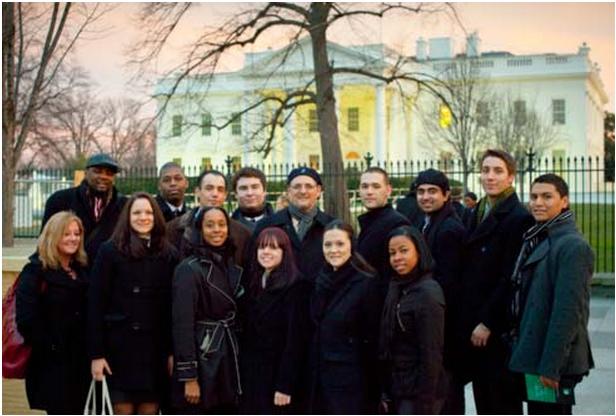FERPA







Montclair State University (MSU) has been described by Forbes magazine as “New Jersey’s best public university” due to its top notch academic programs. With a student-to-faculty ratio of 17 to 1, an average class size of 23 students, state-of-the-art facilities and over 300 majors and minors, (MSU) offers an unparalleled learning experience for its students.
Among its top notch degree offerings is the Bachelor of Arts in Jurisprudence. The Jurisprudence major provides students aspiring to go to law school and other graduate study a solid academic foundation. Through the Jurisprudence major at MSU, students get the fundamental knowledge that is important to understanding legal process and institutions. There are fewer than a dozen such programs in the country.
(More on News at LAWS.com, contact Adam for interviews “adama@laws.com”)
Students interested in law school can gain admission to a well-respected law school through Montclair State University. New York Law School (NYLS) and MSU have a cooperative program that guarantees a student admission to NYLS if he or she completes the major in Jurisprudence and fulfills additional requirements. What is special about this program is that it focuses on a student’s academic accomplishments to determine admission rather than his or her Law School Admission Test (LSAT) score.
Dr. Marilyn Tayler has been with MSU since 1975, and has mentored countless students seeking admission to law school. Dr. Tayler is Jurisprudence Program Coordinator and University Pre-Law Advisor at MSU, and has talked to laws.com about the Jurisprudence major and how students can gain admission to NYLS through it.
Students can take the jurisprudence major with a view to pursue admission at any law school. In what ways does the jurisprudence major at Montclair State University prepare students for the rigors of law school?
We have a jurisprudence major. It is not a pre-law major; there is a real difference between them! A pre-law major is designed to duplicate the Socratic method and what one would get in law school. What we have designed is what we call a law in the liberal arts major; it is even broader than a law in society major. It is designed to teach students about law in relation to a number of disciplines in the social sciences and the humanities so that they get a broad idea of what law is about. Students get to understand relationships such as law and psychology, law and literature, law and philosophy, law and political science, law and government, law and sociology and so on. That is a key element of our major.
It is important to note that for the jurisprudence major we are not looking for a mass of students! In fact, we have a required GPA which is one notch under the Honors Program; because we want to send the message to students that if you are serious about going to law school you have to be a focused and good student! We are not trying to get a lot of students.
The hallmark of our program is a year-long interdisciplinary research and writing seminar where students choose a topic that involves law and at least one other discipline. For example, students have researched topics such as the law and politics of physician-assisted suicide, the law and ethics of paid organ donor banks, the law and literature of Uncle Tom’s Cabin. Through this program, students look at law as interdisciplinary study. You may say this does not prepare you for law school, but it really does. This major gives you the vocabulary of law, the world of law and knowledge of law in the liberal arts that gives you a broader view, which truly prepares you for law school. Then, coming from this broader background, once in law school, you learn the Socratic method of thinking like a lawyer. Graduates of the Jurisprudence major who have gone on to succeed in law school are the proven testimonial to the success of this approach.
I just wrote an article that appeared in the Pre-Law Advisors National Council magazine, PLANC, which goes to every law school admissions director and every pre-law advisor in the country. The article was entitled The Ripple Effect of the New Normal. The idea is that the job market is tough for lawyers, and in response to that job market, law schools are giving students more applied preparation. That means more internships, more clinics, and more summer associate positions to try to help students build a resume, because law firms no longer want to train students on their dollar. They want students to be primed and ready for work when they walk in. There is a ripple effect of that down to the undergraduate education. For example, 25 or 30 years ago, if I were a pre-law advisor, I might tell a student that as long as you get a strong liberal arts preparation you can go to law school. Back then, it did not matter if you had never looked at a law book before. In fact, I went to law school with a PhD in Spanish! I had never previously studied anything related to law and that was okay, because law school gave me all the theory and everything I needed and practical training would occur in the real world of legal practice after law school.
At a recent national conference of pre-law advisors, and there was a law school dean who spoke and he said he calls every entering student to find out what areas of law they are interested in and by December of their first year in law school, he expects them to know where they want to spend their first summer associate position. Now, can you imagine if you just walked into law school with an English major, which is a great major for law school, but you do not know anything about law? So that is why you need either something like the jurisprudence major if you want to study law in depth, or, at the very least, you need a pre-law minor. The pre-law minor provides an alternative to the jurisprudence major, for students who want to experience the world of law in a more limited and focused way.
You need to walk into law school having a knowledge of legal vocabulary and the world of law. We have also restarted our pre-law internship, because we want students to be exposed to shadowing a lawyer and seeing what the real practice of law is about. The point is that in today’s job market, with law schools preparing students more pragmatically for the world of the job, then undergraduate schools really have to prepare students for the world of law! You cannot walk into law school totally and blissfully ignorant, and expect four months later to decide where you want to spend your first summer associate’s position! So that really argues for our jurisprudence major or our pre-law minor.
An important note about the jurisprudence major is that many of our students do not go on to law school. Many take it because they are interested in law. We recommend taking Jurisprudence as a double major, because it is interdisciplinary, and the major we recommend that it probably goes best with, although it goes well with almost any major, is political science. In the jurisprudence major, students study issues both from the vantage points of law and politics, and political science is a great analytical major! That is why political science is the single most popular major for students going to law school, because it teaches them how to think and reason analytically.
What are the advantages for a student to try to gain admission to the New York Law School Guaranteed Admission Program as opposed to try to gain admission to law school through the traditional route?
There is one tremendous advantage and that is the New York Law School agreement allows us to weigh the student’s work in the jurisprudence major instead of weighing the LSAT. In other words, there are many students who do really well in school but who are poor standardized test takers, and this gives outstanding students who do really well in school an opportunity to gain admission to an A.B.A. accredited law school in our area.
What are the eligibility requirements to gain admission to New York Law School through this program?
A student must have a 3.5 GPA in the jurisprudence major, or a 3.4 GPA if they are a transfer student to gain admission to New York Law School through this agreement.
There is an application they must complete and our committee looks at their credentials. They must also average an A in the senior seminar.
For high schoolers interested in entering the jurisprudence program, what are the requirements to gain admission to it?
The requirements are that a student must be in the top 20 percent of their graduating class or alternatively, if they enter MSU and are not in top 20 percent of their graduating class, then they are required to have a B average overall in their freshman year or a B average in the first three courses that they take in the major.
In the six year history of this program, how many students have been able to gain admission to New York Law School through it?
Five Jurisprudence students have gained admission to this program so far. There are two reasons why this number is low. First, as I mentioned, this is a selective program, and second, a lot of high achieving students with high LSAT scores choose to enter New York Law School or other law schools through the traditional admissions process because they may get additional merit based financial aid.
To learn more about the New York Law School Guaranteed Admission Program please visit here. To learn more about Montclair State University’s other great programs, please visit their site. To learn more about education laws and news, please visit our Education Laws Page.
Interviewed with Dr. Marilyn Tayler of Montclair State University, Monctlair, New Jersey by Adam Abdelaziz.

Montclair State University’s (MSU) Political Science and Law Department offers students a strong foundation in both politics and law, and students are taught to look at the subjects of politics and law from an interdisciplinary perspective. The Department enhances its students’ knowledge of politics, government, public affairs and the legal process. Beyond this, it seeks to educate the whole student about the responsibilities of good citizenship. Political Science and Jurisprudence students at MSU are taught how to practically apply the theories they learn in the classroom.
(More on News at LAWS.com, contact Adam for interviews “adama@laws.com”)
At the graduate level, the Department offers a Master of Arts in Law and Governance has four concentrations from which to choose as well as a Certificate in Conflict Management in the Workplace. The concentrations offered include Conflict Management and Peace Studies; Governance, Compliance and Regulation; Legal Management and Intellectual Property. The Master of Arts in Law and Governance at MSU provides academic opportunities that have led to genuine career enhancement for its graduates. For examples, graduates of this program have found employment in the large accounting firms in partner track positions, pharmaceutical intellectual property and corporate compliance, state and federal agencies, international NGOs, and many areas of conflict management as negotiators, arbitrators, and mediators.
The following is an interview conducted by laws.com with Professor Jack Baldwin LeClair, University Distinguished Teacher and Chair of the Political Science and Law Department at MSU. He talks to laws.com about the Department, what it offers its students in terms of a truly global education, its future plans, and what other graduates have gone on to do.
What are some of the hallmarks of the Montclair State University Political Science Program?
Given its relatively small size of 12 faculty members, the department has great expertise in a wide variety of areas, We cover Russia, China, the Middle East, Central and South America, Western Europe and Sub-Saharan Africa.
We try to educate the whole student, not only providing a theoretical foundation, but also trying to orient our students as good national and world citizens by applying their developed expertise for the public good within the context of their chosen careers.
What have students gone on to do after completing a degree in Political Science at Montclair State University?
Many of our students continue to masters and doctoral programs. Quite a few of our students, of course, go on to law school, either through the Political Science major or the Jurisprudence major. Many of our students double major and we encourage our best and brightest to do so. We have integrated the course offering of both programs so that they overlap. In our last five year review, our outside reviewers noted that we have achieved to a large degree what many much more famous schools have attempted, which is the integration of the core curriculum of political science and jurisprudence.
What are some of the future plans of the Political Science and Law Department at Montclair State University?
We have started what we call the International Initiative. We are trying to take the curriculum that is relevant to study world affairs globally. We started last spring with what we called the Turkish Course; it was a real-time synchronized course with Bilkent University in Ankara Turkey. Bilkent University is one of that region’s, if not the world’s, finest universities. It was a real-time class taught by one of our professors and one of theirs and the classes were merged using sophisticated telecommunications to enable students to be virtually in the same classroom. We have other well developed internship programs in public administration and international relations which are less glamorous but valuable in different sub-disciplines of Political Science.
This was a pilot project under the auspices of the US State Department and it was actually former US Secretary of State Hillary Clinton’s pet project, because she was seeking cultural diplomacy or a “Soft Diplomacy” as it is called in political science circles. The program allowed us to electronically bring to the classroom people like Marc Grossman, former United States Ambassador to Turkey, and other influential diplomatic experts from around the world. This sort of cultural exchange that is facilitated by technology is called eDiplomacy. s In addition to students sharing a classroom with their Turkish counterparts, working on joint projects together in political science, two internships with U.S. State Department were generated for our students. One of these internships will be in Turkey, where we are sending a student to study at Bilkent University, and the other is a US State Department domestic internship for one of our students. This is a leap forward for our department and our university! We are trying to develop a similar project with a Greek university, and next spring we hope to run another US State Department sponsored project in another region of the globe. This will allow students to learn from and interact with another culture and country in both an intellectual and a practical way that would not be possible otherwise.
To learn more about Montclair State University’s Political Science and Law Department, please visit their site. To learn more about Montclair State University’s other great programs, please visit here. To learn more about education laws and news, please visit our Education Laws Page.
Interviewed with Professor Jack Baldwin LeClair of Montclair State University, Montclair, New Jersey by Adam Abdelaziz.